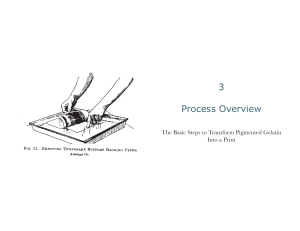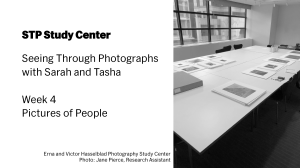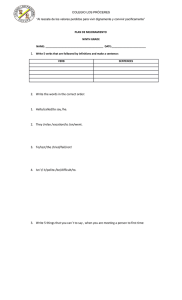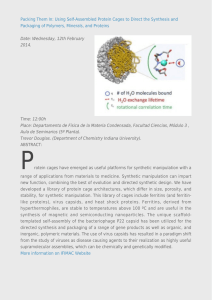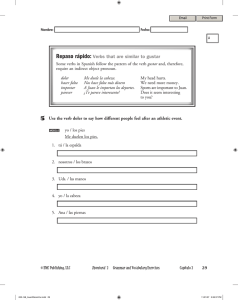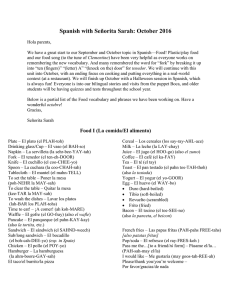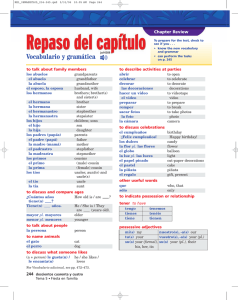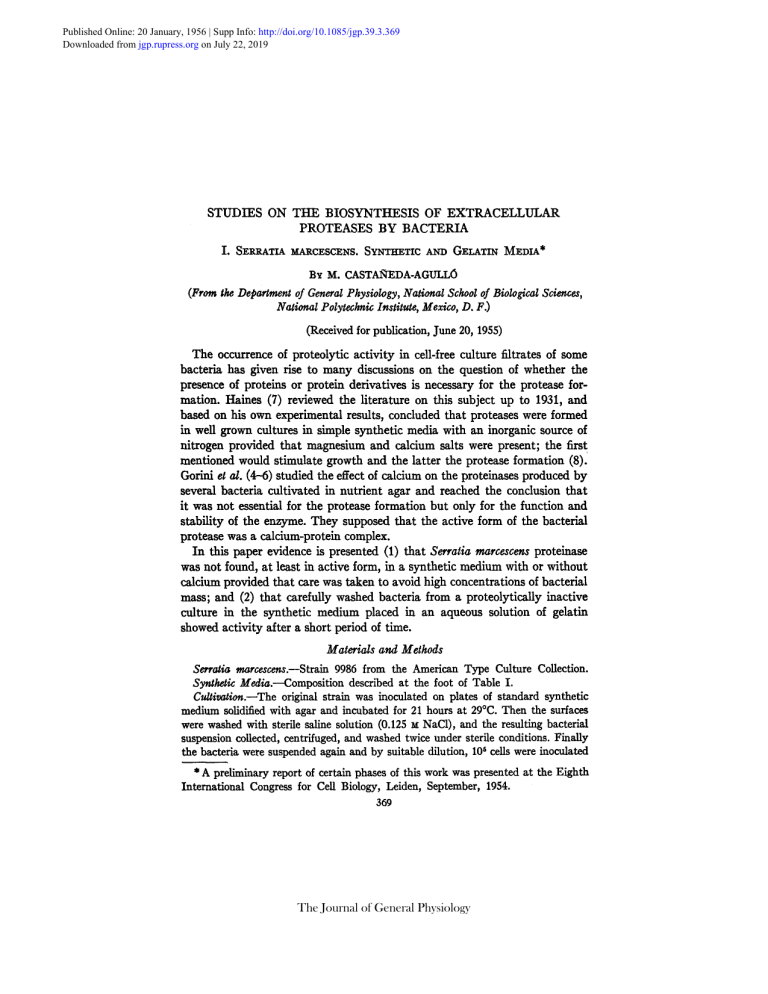
Published Online: 20 January, 1956 | Supp Info: http://doi.org/10.1085/jgp.39.3.369 Downloaded from jgp.rupress.org on July 22, 2019 STUDIES ON THE BIOSYNTHESIS OF EXTRACELLULAR PROTEASES BY BACTERIA I. S E ~ T ~ MARCESCENS. SYNTHETIC AND GELATIN MEDIA* BY M. CASTAI~DA-AGULL~ (From the Department of General Physiology, National School of Biological Sciences, National Polytechnic Institute, Mexico, D. F.) (Received for publication, June 20, 1955) The occurrence of proteolytic activity in ceU-free culture filtrates of some bacteria has given rise to many discussions on the question of whether the presence of proteins or protein derivatives is necessary for the protease formation. Haines (7) reviewed the literature on this subject up to 1931, and based on his own experimental results, concluded that proteases were formed in well grown cultures in simple synthetic media with an inorganic source of nitrogen provided that magnesium and calcium salts were present; the first mentioned would stimulate growth and the latter the protease formation (8). Gotini el a/. (4-6) studied the effect of calcium on the proteinases produced by several bacteria cultivated in nutrient agar and reached the conclusion that it was not essential for the protease formation but only for the function and stability of the enzyme. They supposed that the active form of the bacterial protease was a calcium-protein complex. In this paper evidence is presented (1) that Serratia marcescens proteinase was not found, at least in active form, in a synthetic medium with or without calcium provided that care was taken to avoid high concentrations of bacterial mass; and (2) that carefully washed bacteria from a proteolyticaUy inactive culture in the synthetic medium placed in an aqueous solution of gelatin showed activity after a short period of time. Materiels and Methods Serratia n~rcescens.--Straln 9986 from the American Type Culture Collection. Synthet/c Med/a.mComposition described at the foot of Table I. Cu/ti~ion.mThe original strain was inoculated on plates of standard synthetic medium solidified with agar and incubated for 21 hours at 29°C. Then the surfaces were washed with sterile saline solution (0.125 ,~ NaC1), and the resulting bacterial suspension collected, centrifuged, and washed twice under sterile conditions. Finally the bacteria were suspended again and by suitable dilution, 10s cells were inoculated * A preliminary report of cer~in phases of this work was presented at the Eighth International Congress for Cell Biology, Leiden, September, 1954. 369 The Journal of General Physiology 370 B I O S Y N T H E S I S O~F E X T R A C E L L U L A R P R O T E A S E S . I in 25 ml. of liquid medium contained in a 125 nO.. Efleumeyer flask and incubated during 21 hours at 29°C. By successive subcultures under the same conditions good growth and supernatants entirely devoid of proteolytic activity could be obtained. Calcium.--Sterile stock solutions of calcium chloride were prepared at such concentrafions that when added to media in the proportion 1:25 the final molarities were 3.6, 18, 55, and 90 X 10"4. Measure of G-rowth.--The concentration of bacteria was estimated by a nephelometric method adapted to S. marcescens and controlled by plate count. Following the suggestion given by Monod (10) and Finney et al. (3), logarithms to base 2 were used for the graphical representation of growth because each increase of 1 unit of the log TABLE I Influetw¢ of Bacterial Growth, as Limited by the Conxen#ratlon of Nutrients in Medium, on the Formation of Proteases by Sarratia marcescens Medium without calcium Medium Concentration referred 48 hrs. to standard Baeteriaper medium* mL 1 X 2 X 3 . 4 X lOS 4.4 X 108 4X 8X 4 . 6 X 108 7 X los '[T.U.]~u" per ml. of supernatant Medium with calcium 3.5 X 10-4 48 hrs. 168 hrs. Bacteria per mL 3 X 5.6X 8.4 X 13.6 X 108 los 10s 108 168 hrs. [T.U.]~" [T.U.]~a' per ml. Ba¢ ~ri~ per per ml. Bacteria per of m]. of ml. supernasuperngtant tant 0 0 0 0 3.2 3.8 4.1 5.8 X X X × 108 2.4 0 0.43 4.2 los los 14.2 5.7 108 15.1 11.2 × N X X IT.U.I~u per ml. of supernatant los 0 los 1.69 los 18 l0 s 19.4 * 1 N standard medium: diammonium dtrate, 0.625 gin.; monopotassium phosphate, 0.375 gm.; anhydrous sodium carbonate, 0.375 gin.; sodium chloride, 0.250 gm.; magnesium sulfate, 0.125 gin.; glycerol, 6.25 ml.; distilled water to 1000 ml.; pH adjusted to 6.5 with HC1. Sterilization at 115°C. for 15 minutes. 2 × , 4 × , and 8 × : media having the same constituents as the standard but with twice, four, and eight times its concentration. scale in relation to the log2 of the initial number of bacteria corresponds to one cellular division. Gelatin Medla.--Difco bacto gelatin was used to prepare a concentrated medium dissolving 1.544 gin. (total N, 0.247 gin.) in distilled water to 100 ml.; p H was adjusted to 6.5 with 0.05 • NaOH and the solution sterilized at 100°C. for 30 minutes. In order to obtain the best results, gelatin solutions must be freshly prepared and sterilized in concentrations greater than those to be used. The final dilution with sterile distilled water was carried out immediately before the experiment, pH was verified in samples drawn using bacteriological techniques, and readjusted to 6.5 by the addition of sterile 0.05 N NaOH. Induction Mahod.--Into a series of sterile antibiotic vials of 20 ml. capacity, 8 ml. of each medium were placed using bacteriological methods. Bacteria separated by centrifugation from 21 to 22 hour old cultures in the standard synthetic medium and washed twice with saline solution were suspended in the volume necessary to give a 371 M. CASTA~'EDA-AGULL6 concentration of 4 X 10° per ml. Into each vial 0.1 ml. of bacterial suspension was added and the vial introduced into water bath at 29°C. After each period of time the bacterial growth was stopped adding 0.16 ml. of 1:1000 merthiolate solution, the cultures were centrifuged, and the proteolytic activity of the supernatants determined. Measure of the Proteolytic Activity.--Northrop's phenomenon (2) makes possible the measure of the bacterial extracellular protease activity in gelatin solution on a casein substrate without interference produced by the hydrolysis of gelatin. In the search for a sensible micromethod which permitted the detection of the small quantifies of protease liberated by bacteria, tests were made with crystalline trypsin dis8- c _e 0 o ~r 4 eJ .c 2 2 g 0 o 5J q. I eo ' I I I i 0.1 . I I ,,I 0.2 0.3 0.4 Hicrograms of crystalline trqpsin FIG. 1. Standard curve for 18 hour digestion at 37°C. of casein by crystalline trypsin diluted with aqueous solution of gelatin (0.6176 mg. total N per ml.). No difference in activity was observed as result of solvent action when solutions of trypsin in synthetic media, saline solution, distilled water, and 0.0025 ~ HC1 with and without calcium were tested. solved in the various media used for the experiments with S. marcescens, acting on Kunitz' casein substrate (9) with 0.002 per cent of merthiolate during different times and 18 hours was found the most convenient to estimate as small activity as that corresponding to 0.01/~g. of crystalline trypsin (Fig. 1). The procedure for the quantitative determination of the proteolytic activity was the same as that used in previous work (2). Units of Acti~ity.--The activity of the protease released by S. marcescens is expressed comparatively with crystalline trypsin in terms of trypsin units. A trypsin unit [T.U.]¢~• is defined as the quantity of trypsin which liberates a milliequivalent X 10-a of tyrosine per hour per milliliter of casein substrate at 37°C. (Fig. 1). This unit is similar to Anson's (1) and Kunitz' (9) but the units of these authors are expressed in relation to I minute. 2.5 -28.0 -- 2.04 E |°~ E L. ~. - 27.0 f.. Q. L 1.0- -~.65 0.5- : 26.0 0 i, . i 0 I I I00 I 2O0 ! , ,I I i • a:l ,25~5 ! 5 o o min. c300 Time FIo. 2. Induction by gelatin of extracelhlar protease activiW in S. marcescens. Curve 1, proteolytic activity induced by aqueous gelatin (0.62 nag. total N per ml.) p H 6.5. Curve 2, growth in the same gelatin solution. Curve 3, proteolytic activity in the standard synthetic medium with and without calcium. Curve 4, growth in the standard synthetic medium without calcium and with 3.6 X 10 -4 M Ca. Curve 5, growth in standard synthetic medium with 18 X 10 -4 Ca. Curve 6, growth in standard synthetic medium with 55 × 10 -4 M Ca (equimolecular to the phosphate and citrate in medium). Each arrow indicates one cellular division. Water and saline solution controls with and without calcium did not present either activity or growth. TABLE I I Influence of Calcium on the Proteolytic Activity of Serratia Synthetic Medium 24 hrs. Calcium molarity in medium 0 0.72 X 3.6 X 18 X 55 90 X X Bacteria per ml. 3.7 3.2 3.22 I0"~ 2.96 I0-~* 3.16 104 2.94 104 I0 "4 >(IO s XIO s X los X lOS X I0s X IOs marcescens Cul~a'e.sin Slandard 48 hrs. ['r.u.]~,"" Bacteria per per ml. oz m|. supernatant per mL of supernatant 0 0 0 0 0 0 127 hrs. [T.U.]~*' per ml. of mpernatant 3.4 X l o s 3.22 X los 3.2 X lOs 0 0 0 3.22 X los 3.12 X l0 s 0 0 2.8 l0 s 0 los 0 0 0 2.6 >(10 s 2.9 X lOs 2.42 X los 0 0 0 2.8 × 3.16 X 2.86 X I0s IOS * Equimolecular to the phosphate and citrate in the standard medium. 372 X M. CASTA..~EDA-AGI~.~I~ 373 RESULTS The formation of protease in the synthetic media studied depended on the number of bacteria per mliiiter attained, which is determined by the concentration of nutrients and the age of the culture. Calcium was found to be essential for enzyme activity in synthetic media (Table I). In a dilute medium such as the 1 x standard used in this work no protease activity could be detected 5 E L L.5 .~ 26.7 u ! ~6.5 0 ' 5 ' ' O ' ~ 7 ' 8 : 9 26.4 pH FIG. 3. Protease induction in S . m a r c h e r , s as function of gelatin pH. Curve 1, proteolytic activity induced by aqueous gelatin (0.6176 rag. total N per ml.) at different pH. Curve 2, growth in the same solutions. despite the presence d calcium at different molarities including one concen, tration which was equivalent to the phosphate and citrate of the mediumas can be observed in Table If. Fig. 2 shows that carefully washed bacteria from a proteolytically inactive culture in I x standard medium piaced in an aqueous solution of gelatin presented activity from 150 minutes onward. The same number d bacteria in the synthetic medium with various concentrations d calcium apparently had no activity after S00 minutes and reached a larger increase in bacterial mass than on gelatin. The effects of gelatin solvent on the appearance of protease 374 BIOSYNTHESIS O]~ J~XTRACELLULAR PROTEASES. I activity and growth were in opposition; while more activity was present in aqueous solution of gelatin, growth was greater in saline gelatin solution. See Fig. 4. . 4 27.Z t~'2. 0.5 o.ez' ~.o Cielaffn N per" ml.-To'lal ~ mcj. FIG. 4. Effect of gelatin concentration on the extraceUular proteolytie activity of S. marcescens. Curve 1, proteolytic activity in several concentrations of aqueous gelatin. Curve 2, growth in the same solutions. Curve 3, proteolytic activity in several concentrations of gelatin in saline solution. Curve 4, growth in saline gelatin solutions. TABLE III Influence of Calcium on the Protease Induction by Gelatin in Sa'ratia maecescens Calcium molarity 0 3.6 X 104 18 X 10-" 55 X 104 Bacteria per ml. 9.6 9.6 9 9.5 X X X )< 10T l0 T l0 T l& [T.U.]~aj" per ml. of supernatant 2.35 2.35 2.25 2.30 Inoculum, 5 )< l& bacteria per ml. Total gelatin N per nil., 0.6176 nag.; pH 6.5. Induction time, 500 minutes at 29°C. Figs. 3 and 4 demonstrate that the optimal p H was 6.5 and the concentration of gelatin which gave the best protease activity for the number of bacteria used, 0.62 rag. of gelatin nitrogen per ml. Calcium did not manifest any" influence on the bacterial protease activity induced b y gelatin (Table I I I ) . M. CASTAIr~DA-AGULL~ 375 DISCUSSION In protein-free synthetic media no proteolytic activity is found unless a certain number of bacteria has been reached and calcium is present. Therefore, the suggestion is possible that either the proteins of dead bacteria or proteic derivatives of metabolism, formed only when the culture has attained a high concentration of bacterial mass, are the agents responsible for the protease formation. This view may also be supported by the following observed facts: first, a given number of bacteria placed in a low concentration of gelatin gives rise to the rapid appearance of increasing amounts of protease in the medium before one cellular division has been brought about; and second, the same number of bacteria in standard synthetic medium with or without calcium does not present activity, at least appreciable by the micromethod used, during the same interval of time and under identical conditions, in spite of undergoing about two divisions. Calcium is not necessary for the stability of the enzyme produced in gelatin media, probably because gelatin acting as a substrate would protect its activity. SUMMkP,¥ Apparently the extracellular protease of S. marcescens is present in proteinor protein derivative-free media only when the conditions favor an abundant growth and bacterial conglomerates are formed, which possibly could be explained by assuming that the proteins of dead bacteria or proteic metabolic products act as inducers of protease formation. Dilute solutions of gelatin induce the production of proteolytic activity after a short period of time and its rapid increase before the initial number of bacteria has been duplicated. Calcium is necessary to preserve the activity of the enzyme formed in synthetic media but not that produced in gelatin. BIBLIOGRAPHY 1. Anson, M. L., J. Gen. Physiol., 1938, 22, 79. 2. Castafieda-AguUS, M., ]. Gen. Physiol., 1956, 39, 361. 3. Finney, D. J., Hazlewood, T., and Smith, M. J., J. Gen. Microbiol., 1955, 12,222. 4. Gorini, L., and Fromageot, C., Biochim. et Biophysic. Acta, 1950, 5, 524. 5. Gorini, L., Biochim. et Biophysic. Ada, 1950, 6, 237. 6. Gorini, L., and Crevier, M., Biochim. et Biophysic. Acta, 1951, 7, 291. 7. Haines, R. B., Biochem. J., 1931, 9.5, 1851. 8. Haines, R. B., Biochem. J., 1933, 9.7, 466. 9. Kunitz, M., J. Gen. Physiol., 1947, 30, 291. 10. Monod, J., Ann. Rev. Microbiol., 1949, 3, 371.
